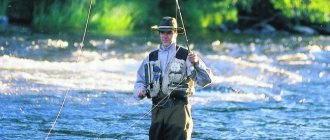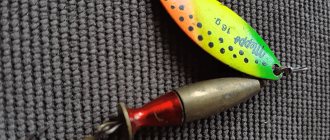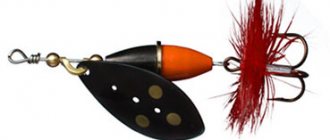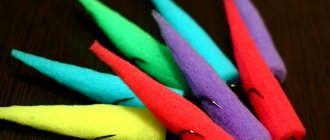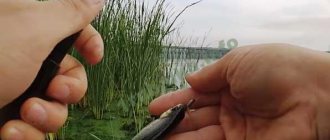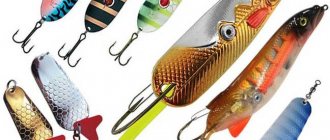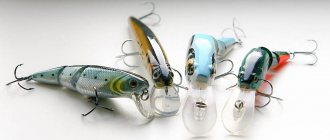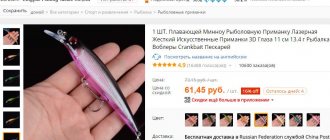Can large pike be caught on dead fish?
Pike fishing in the fall can yield large specimens. Most often this happens in November. But when choosing this fishing method, you need to understand that large pike are looking for food at the bottom, which means that the gear must be such that it can easily deliver the bait to this part of the reservoir. In addition, it is better to choose the most durable gear, because large fish have much more strength, which increases the risk of damage to the rod.
Effective ways to catch pike
There are a large number of ways to catch pike. The choice depends on the fishing season and the desired result. The most effective are:
- spinning fishing from the shore or boat (in this case, any bait can be used), including spinners;
- fishing with live bait, including using special circles;
- float fishing with live bait from the ice until the end of March.
Suitable float rods and bottoms
You can catch dead fish using a wide variety of gear. Telescopic float rods, bottom rods, and feeder blanks are also suitable.
In the case of float fishing, it must be a powerful rod with a serious margin of safety, since both casting and fishing for pike place a large load on the tackle, which the same light “bleak” fishing rods are not able to withstand. You will also need a float of appropriate carrying capacity, since the best results when fishing with float gear can be achieved in cases where the dead fish is kept at a short distance from the bottom or thickets of aquatic vegetation. Most often, models with a length of 4 or 5 meters are used; with longer options, when actively feeding the bait, the hand quickly gets tired. If the fishing rod is installed on a stand, its weight does not play a special role.
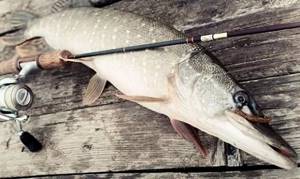
You can use any gear to catch dead fish.
Fishing rods, usually used as donks, usually have a sufficient margin of safety for casting dead fish and landing pike. Often these are also telescopic rods, but shorter in length than float rods - 2.4, -2.7 meters are the most popular, as they provide both sufficient casting range and ease of working with tackle in confined spaces (for example, in areas overgrown with vegetation). shore or under the crowns of trees hanging low over the water).
Feeder rods are also suitable for this kind of fishing, but not all. The requirements for them are as follows:
- Heavy or extra heavy class. Feeder rods with a weight of less than 120-150 grams are not suitable, as they cannot cope with casting a fairly large bait.
- The length is 3 meters or more, which will allow you to throw dead fish to fishing points remote from the shore.
- The preferred action is parabolic, since such blanks successfully dampen the jerks of trophy fish. However, it is worth considering that fast models provide an advantage in accuracy and control when fishing.
Important! When fishing with donks and feeders, it is quite possible to use feeders with bait. This can be either a traditional mixture, which attracts small fish, the school of which will later be approached by a predator, or chopped fish, which directly attracts pike.
Collecting fishing gear
There are some requirements for a dead fish rig:
- possibility of throwing at 20−30 m;
- the bait (i.e. dead fish) should sink easily and take a natural position at the bottom;
- have a service life of at least 20 casts, and preferably at least 50;
- easy to make with your own hands.
To create such a tackle for pike, you need the following materials and tools:
- wire that bends with difficulty;
- can lid;
- fishing hooks in the form of tees (2 pcs.);
- carbine;
- beads;
- sinker;
- Styrofoam;
- black marker.
Having prepared the necessary tools and materials, you can proceed to making a tackle for a dead fish. The sequence of actions is as follows:
- Cut a piece 10 cm long from the wire. At one end of it, make a ring, onto which you hook a carabiner, and then a tee.
- Pass the second tee through the ring of the hook, and then wrap it with wire several times. After this, put on the bead.
- From the lid, cut out a part that resembles a propeller, but of very small size. Make a hole in the center for the wire, pass it through the propeller, and then secure with a second bead.
- Now you need to make a ring, onto which you can later hook the sinker and leash. But before this, the sinker must be secured to a separate piece of wire, which is placed behind the second bead and in front of the tee.
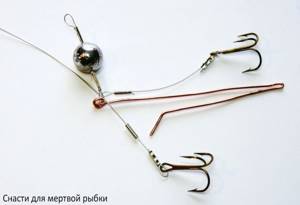
The effectiveness of catching dead fish also depends on the choice of fishing rod; the equipment must be carried out according to the rules:
- For sharp anchors, a flexible rod with a medium action is suitable;
- for fishing in reservoirs without a current, it should be as rigid as possible;
- when on the shore, it is better to take a long rod (about 3-4 m);
- durable, have a weight test of at least 80 g.
Now you can choose bait for your tackle. To catch large pike with dead fish in winter, both freshwater and sea dead bait can be used as bait. But the second option is preferable, since such bait is more affordable. In addition, sea fish have a high fat content, which means they are more attractive to pike in winter. This predator loves herring and mackerel.
It is recommended to use them whole for fishing, which is why you need to buy whole carcasses. It must be remembered that the weight of the bait must correspond to the weight of the intended victim. For large predators, you can use bait weighing at least 200 g. If such specimens are not found in a reservoir, then there is no point in taking such carcasses. The average pike simply cannot take them.
Attention should also be paid to the length of the carcass. It should not exceed 15 cm.
In addition to herring and mackerel, other representatives of marine aquatic fauna are also in demand:
- sardine;
- sprat;
- horse mackerel;
- gerbil;
- garfish;
- mullet;
- whiting.
Any freshwater fish can be used to catch pike. But fishermen prefer roach, rudd and eel pieces.
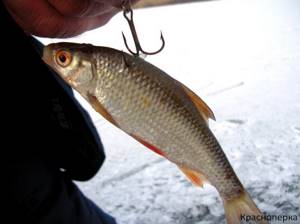
You can buy bait in specialized stores. It is sold frozen, but the quality does not suffer from this.
Features of winter fishing for pike
When going to an unfamiliar body of water at different times of winter, the fisherman must designate the search area for pike depending on the characteristics of its behavior.
Important! If you find snags on a section of the river, before sunrise, drill holes for casting girders and fishing with spinners. In this place, attacks by river hunters will definitely follow.
The entire winter period is divided into 3 periods:
- the time of the first frosts and the formation of the first ice;
- mid-winter, the time when fish are inactive, is called “dead winter”;
- late winter, the period of last ice - pike begin their pre-spawning feast.
Each different season requires choosing different fishing spots.
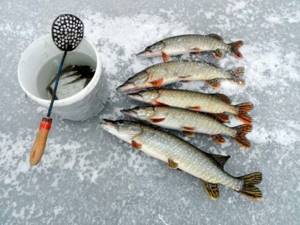
Where to look for pike in winter?
If you go fishing on the first ice, then pay attention to shallow water with thickets of plants; be sure to drill several holes along the border of reed thickets or near flooded coastal vegetation. You should not pass by small creeks; this is where the toothy fish comes out to hunt.
It is more difficult to find pike during the deep winter, especially in an unfished reservoir. If you have an echo sounder, first of all they fish:
- edges of river beds or canals;
- exit areas from wintering pits;
- places with sharp changes in depth;
- areas with fallen trees;
- if you know the outlet of the spring, a pike will definitely strike here.
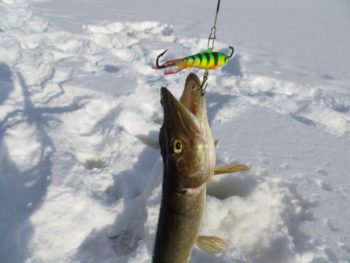
In a little time, you can cast your gear and catch pike. But the period of activity of the predator during this period is several hours, so it is better to go to a familiar river and cast girders in the studied places.
The last ice and the time of pike feeding - at this time the pike takes everywhere, it actively feeds, you need to look for it in places where peaceful fish accumulate. Unlike other periods, pike go to the confluence of melt water streams. In such places, the water has a high oxygen content, and melt water supplies food for small fish. Therefore, you should not pass by such a place.
Knowledge based on scientific research will help the fisherman catch trophy pike at different times.
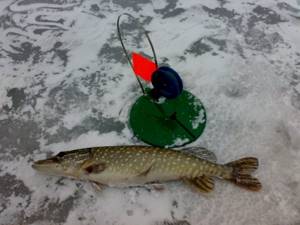
Features of behavior in winter
Several factors influence the behavior of a predator:
- Saturation of water with oxygen.
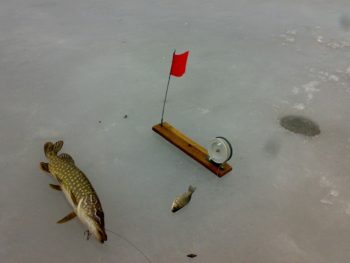
An air sac may form here; the pike moves towards the last reserves of air. During the deep winter period, she can stand near a hole or an unfrozen ice hole. It becomes almost vertical, actively moving its fins, sucking air from the thin gap between the cavity in the ice and the water.
Low air concentration makes the predator inactive, it stands in the water column, and its growth and development slows down. The critical oxygen content is considered to be 83 hundredths of air in a million parts of water. After this, the fish dies.
- Light level.
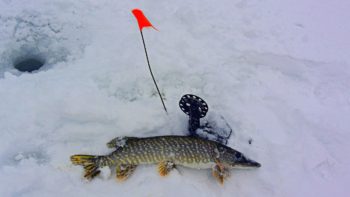
During this period, pike goes hunting. The illumination of the water also affects the effectiveness of its attacks, which is why the fish develops and grows. And this requires additional nutrition, so it attacks any passing prey. Even during the deep winter, on a clear day you can catch an active pike fight, especially during a thaw.
- Influence of water temperature.
The most optimal for the growth and activity of pike is considered to be heating the water to 19-22 0C. When the temperature gets hotter, the pike rolls into holes and just stands in the cool water. But even in winter, at low water temperatures, pike are forced to feed; their activity increases during long thaws and sunny days.
The growth and development of fish slows down; often it uses fat reserves deposited during the autumn feast.
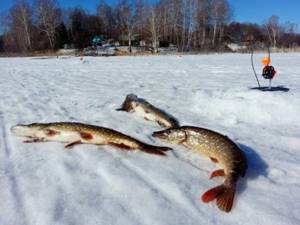
Fishing technique and tactics
The success of fishing depends on the correct technique and tactics. When it comes to pike fishing, there are 2 methods: static and mobile.
The advantage of the static method of catching pike is that such bait is better visible because it has a smell that attracts pike. In this case, you need to plant half the carcass, which will increase the spread of smell throughout the pond. You can also pierce a whole fish in several places.
The equipment used is a sliding bottom sinker or float. In the first case, the equipment may lie on the bottom or float up. In the second case, you need a foam rod, which must be passed along the body of the dead fish. The bait is more visible when suspended. Most often, such float tackle for catching predators is used in muddy areas of a reservoir or with overgrown grass.
When you select a float, the bait becomes suspended. The advantages are that it will not get lost in mud or grass.
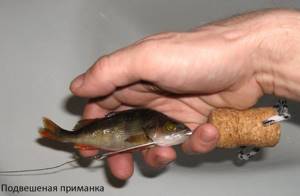
The mobile method of fishing for dead fish involves moving the bait, which allows the pike to react not only to the smell, but also to vibration when moving. There are 3 options for mobile catching that will help you catch pike stock:
- Wobbling bait. The dead fish is placed on the hook by the head and then held in such a way that the bait makes curves with its body.
- Drifting bait. The bait is attached to a float, which moves across the pond with gusts of wind. This method is effective if the fisherman does not know the exact place where the pike is located, or there may be various obstacles in the way of the gear, such as reeds.
- Trolling. This method of mobile fishing involves the use of a float with a sail. The advantages are a large coverage radius, i.e. you can catch pike at a distance of 100 m from the shore.
When choosing a fishing method, you should consider the following facts about pike:
- does not always hunt from ambush; it can pursue its prey for a long time;
- they hunt in groups, so in a short period of time you can catch several specimens at once in one place;
- can migrate in search of food, and appear in places atypical for pike.
How to mount a fish correctly
The success of fishing and whether the pike will like the bait depends on the correct placement of dead fish. It is recommended to pass the leash under the skin of the bait using a bait needle. Tees are subsequently attached to the leash, and they are fixed to the bait with one sting. This method of baiting a fish will not allow the pike to bite through the line, and will also ensure an effective hooking.
Advantages of dead fish compared to other baits
Catching pike with a rig with a dead fish has its advantages compared to other baits:
- The ability to use the same fish longer - the same live bait dies after just one or two casts and needs to be replaced.
- There is no need to catch or buy live bait immediately before fishing - dead fish can be prepared in advance, including frozen ones, and stored in this form for a very long time.
- Installation of hooks is simpler and more reliable, since there is no need to do everything as carefully as possible, trying to injure the live bait as little as possible.
- Also, such equipment fully allows active spinning retrieves, which cannot be said about live bait - live fish quickly dies from tossing and twitching of the tip.
- This bait has a natural scent that attracts predators from a great distance. Moreover, according to a number of fishermen, this effect is more pronounced in dead fish, and not in live bait.
- When attacking, the pike feels the same as when attacking natural prey, and does not spit out the bait, as often happens with spoons or wobblers.
Spinning rods
Spinning tackle is also widely used for catching dead fish. Moreover, such a rod can be used both as a donkey - solely for casting bait to the desired place, and for active animation of such bait. The spinning test should allow you to cast a fairly heavy fish. Trying to use blanks with dough less than 80-100 grams risks breaking the rod, so you should choose the most powerful models. The length depends on the fishing distance - the farther the promising point is located, the longer the spinning rod should be.
Pike fishing in autumn
Method 4
Heat and drag.
- Rod: carp or pike with 2.5 lb.
- Reel: fast, inertialess.
- Line: with a breaking load of 7 kg.
- Leash: wire, 60 cm, breaking load 14 or 18 kg.
- Hooks: single No. 2 or No. 1 and treble No. 6 with one barb.
- Other accessories: swivels No. 10 or No. 7, clamping weights SSG.
- Bait: whole dead fish that holds well on hooks, such as roach, rudd, dace, small herring or smelt.
Drowning and moving or oscillating dead fish are highly effective in all bodies of water. The basic technique is the same, no matter where you fish: cast the bait, let it sink and, reeling in the line, bring it back towards you, with pauses and slight accelerations, being careful in both proportions, or cast the bait, let it sink and cast with short jerks so that it lowers and rises in the water column.
Equipment for fishing using the “Sink and drag” method
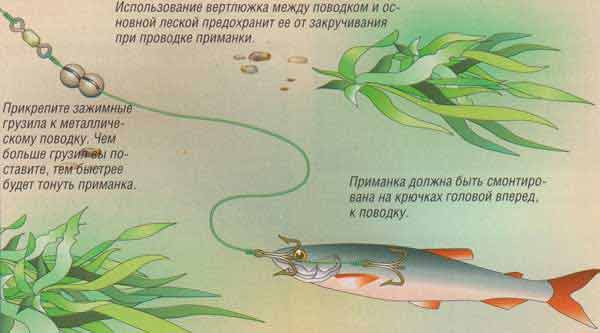
This is one of the simplest pike rigs. The bait, first of all, should be mounted head first in order to look natural when retrieved.
Just like when fishing with artificial bait, the more imagination you put into your presentation, the better. By forcing the fish to rush and glide, you are more likely to attract the attention of the pike than with a monotonous “robot-like” retrieve. A bite manifests itself as a small push or blow on the fishing line. If you feel this, stop the reeling, open the line guide on the reel and let the line come freely from the spool.
Bait wiring method
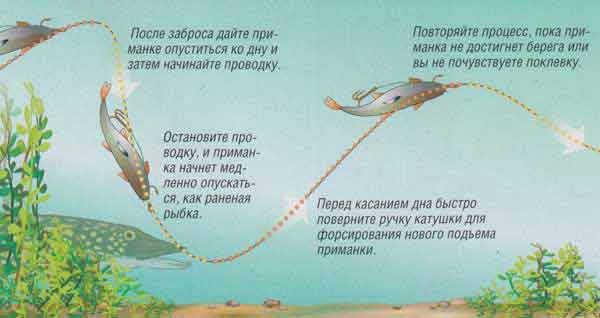
Changing the speed of the retrieve makes the bait look like a wounded fish - it’s easy to do
Equipping the tackle with fish
Depending on the planned conditions and the fishing object, it is necessary to choose the right model of tackle.
When using the Krapivin variant, after rigging the result will be a centrally loaded bait. With this option it is convenient to fish in the upper and middle layers of water. When using other models of rigs, the result will be a front-loaded bait. This option is convenient to use in bottom layers of water.
On a note! If you plan to hunt a fanged predator, then a branch with a tee is attached to the fish in the area of the dorsal fin. And if you plan to hunt pike, then the outlet with a tee is attached to the fish in the area of the anal fin.
Spinning tackle makes it possible to use spaced and non-spaced equipment. And bait based on dead fish is no exception. Using the Krapivin option makes it possible to use equipment with a retractable leash.
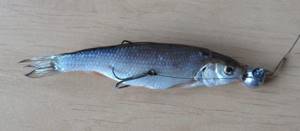
Photo 3. Equipping the Nazarov model with a fish.
What to use to catch pike in summer
Pike fishing gear remains the same all year round.
Summer pike fishing involves two main directions:
- Dynamic and active spinning fishing with artificial and live bait. The arsenal and variety of spinning lures is so great that there are no limits to creativity in spinning fishing.
- Active and passive live bait gear . These gear include:
- Zherlitsy;
- Mugs;
- Float rod.
Having a boat gives a huge priority in catching toothy predators on a body of water. The boat expands the range of gear and fishing techniques that can be used. On the other hand, the boat adds an element of mobility to the fisherman on the pond and makes it easier to fish hard-to-reach places.
The presence of a boat gives the fisherman the opportunity to use an echo sounder, which will allow him to study the topography of the bottom of the reservoir, and therefore promising places for fishing.
